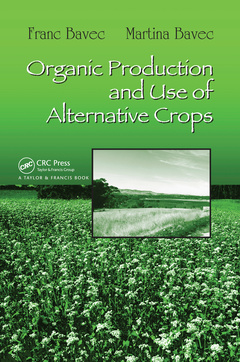Organic Production and Use of Alternative Crops Books in Soils, Plants, and the Environment Series
Auteurs : Bavec Franc, Bavec Martina

Merging coverage of two increasingly popular and quickly growing food trends, Organic Production and Use of Alternative Crops provides an overview of the basic principles of organic agriculture and highlights its multifunctionality with special emphasis on the conservation of rare crops and their uses. Considering more than 30 disregarded and neglected crops suitable for growth in temperate climates, each chapter covers the botany, climate conditions, cultivars, production and yield, growth and ecology, organic cultivation, harvesting, handling and storage, and utilization where the information is available and applicable to the crop under discussion. Other topics include organic production systems, the nutritional and health benefits of products, food processing, and suggestions for some homemade foods.
The authors have a wide range of experience in the growing and processing of alternative crops, the management of the processing projects, and the marketing of organic products. They have worked in close cooperation with many small scale processing activities on farms and in the food industry. Drawing on their combined experience, they provide a summary of the major problems and the knowledge base for utilization of alternative crops in new products. The broad range of coverage and interdisciplinary approach make this book a comprehensive reference and useful tool not only for the production of alternative crops but also for the development of new niche market products.
Date de parution : 12-2019
15.2x22.9 cm
Date de parution : 07-2006
Ouvrage de 240 p.
15.2x22.9 cm
Thèmes d’Organic Production and Use of Alternative Crops :
Mots-clés :
Flax Seed; rotation; Amaranthus Hypochondriacus; seed; Grass Clover Mixtures; ha-1; Intermediate Wheatgrass; buckwheat; Oil Pumpkin; flour; Wild Rice; wheat; Common Wheat; essential; Interrow Spacing; amino; Buckwheat Flour; acid; Foxtail Millet; triticum; Buckwheat Groats; alternative crops; Soil Fertility; gene modified organisms; Salt Water; organic crop management; Hexaploid Triticale; organic agriculture; Proso Millet; Pearl Millet; Fiber Flax; Jerusalem Artichoke; Finger Millet; Vesicular Arbuscular Mycorrhiza; Kodo Millet; Koda Millet; Secondary Fibers; Durum Wheat; Panicle Formation Stage



